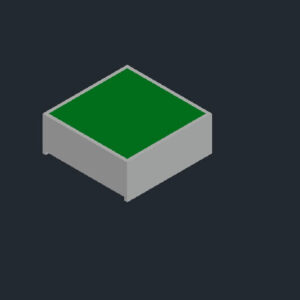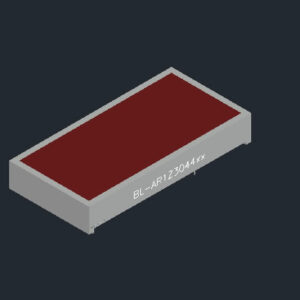Obtain 3D specification files
To examine all 3D specifications, save the files to your local drive and open them with your 3D application.
Lens colors in 3D files are solely for visual representation; consult the Datasheet for accurate lens type and color information.
In the event of a mismatch, the dimensions in the datasheet take precedence over the 3D specifications.

LED light bar(rectangular,17*15.00mm)
Lightbar LED
Elevating Design with the LED Bar Graph: A Revolution in Lighting Technology
In the realm of electronic illumination, the LED bar graph, especially when it comes to the rectangular 1 bar, 17*15.00mm, stands out as a beacon of innovation and efficiency. Tailored for a broad spectrum of applications, this lighting solution captures the attention of electronics manufacturer engineers, purchasers, and administrators alike, offering a blend of aesthetic appeal and functional brilliance. This article delves into the features, applications, benefits, and real-world impacts of using these LED light bars, enriched with case studies and user testimonials to provide a comprehensive understanding of their transformative potential.
Innovative Features of the LED Bar Graph
The LED bar graph, particularly the variant with dimensions of 17*15.00mm, is celebrated for its compactness, energy efficiency, and remarkable brightness. Unlike conventional lighting solutions, these LED bars offer enhanced durability and versatility, making them an ideal choice for both sophisticated electronic devices and high-demand industrial environments. With the capacity to operate under low power while providing optimal luminosity, they serve as a testament to the advancements in LED technology, merging functionality with environmental sustainability.
Applications Across Industries
The utility of the LED bar graph extends across various sectors, including automotive, consumer electronics, aerospace, and industrial machinery. Their ability to provide clear and immediate visual feedback makes them indispensable in control panels, instrumentation, and portable devices. Moreover, their robustness and energy efficiency align perfectly with the demands of outdoor signage and emergency lighting, showcasing their adaptability and relevance in modern applications.
A Deep Dive into the Benefits
Choosing an LED bar graph for your projects brings forth a plethora of advantages. Notably, their long lifespan and low energy consumption translate to significant cost savings over time, not to mention the positive environmental impact due to reduced energy waste. Additionally, their compact size and ease of integration allow for creative design possibilities, enhancing the aesthetic and functional value of products.
Case Studies: Illuminating Success
Real-world implementations of the LED bar graph illuminate its effectiveness and versatility. For instance, in the automotive industry, these LED bars have been instrumental in developing more intuitive and energy-efficient dashboard displays. Similarly, in consumer electronics, they have enabled sleeker and more responsive user interfaces, highlighting their capacity to drive innovation and improve user experiences.
Hearing from the Users
Testimonials from engineers and purchasers underscore the LED bar graph’s role in elevating product design and functionality. Administrators applaud its reliability and cost-effectiveness, noting substantial improvements in operational efficiency and product appeal. These firsthand accounts provide valuable insights into the practical advantages and transformative potential of LED light bars in professional settings.
Navigating the Selection Process
Choosing the right LED bar graph involves considering factors such as dimensions, brightness levels, and intended application. This section guides readers through making informed decisions, ensuring the selected LED bars meet their specific needs and enhance the overall design and performance of their projects.
The Path Forward: Trends and Innovations
The future of LED bar graphs looks bright, with ongoing research and development poised to unlock even greater efficiencies, design possibilities, and applications. As technology evolves, these LED bars will continue to play a pivotal role in shaping the future of lighting and electronic design, offering a glimpse into the innovative solutions that lie on the horizon.
Concluding Thoughts
The rectangular LED bar graph, with its dimensions of 17*15.00mm, represents a significant leap forward in lighting technology. Its blend of efficiency, versatility, and aesthetic appeal makes it a preferred choice among professionals across various industries. By leveraging the insights and recommendations provided in this article, readers can harness the full potential of these LED light bars to illuminate their projects and drive innovation.
Call to Action
Discover the transformative power of the LED bar graph for your projects. Explore our selection and harness the benefits of advanced lighting technology today.

Features
- Display Area Shape: Rectangular, providing a clear and distinct area for illumination.
- Display Area Number: Features one display area.
- Reflector Dimensions: Length of 17.00mm and width of 15.00mm, offering a balanced size for visibility and compactness.
- Uniform Light Emitting Area: Ensures consistent and even lighting across the display.
- Low Current Operation: Energy-efficient, leading to reduced power consumption.
- Wide Viewing Angle: Allows the display to be easily visible from various angles.
- Easily Mounted on P.C. Boards: Designed for straightforward integration into electronic systems.
- Flush Mountable: Can be installed to align seamlessly with the surface, ensuring a neat appearance.
- Excellent On/Off Contrast: Provides clear visibility, enhancing readability when illuminated.
- Can be Used with Panels and Legend Mounts: Versatile in terms of installation, suitable for various types of panels.
- Categorized for Luminous Intensity: Ensures uniform brightness across different units.
- Different Colors in One Unit Available: Offers flexibility in color choices, enhancing customization.
- Standard: Black Face, White Segment: Classic appearance for easy identification and readability.
- RoHS Compliance: Meets environmental and safety standards.
Applications
- Indicator Lights: Ideal for applications requiring clear indicator lights in electronics, machinery, or other equipment.
- Control Panels: Suitable for use in control panels in devices, vehicles, or industrial machinery.
- Signal Lights: Applicable in settings where clear, visible signal lights are needed.
- Instrumentation Displays: Useful in displaying status or readings in instrumentation panels.
- Consumer Electronics: Can be integrated into various consumer electronic devices for display or indication purposes.
- Safety and Emergency Equipment: Suitable for use in safety devices requiring clear indicator lights.
- Information Displays: Effective in information displays in public areas or systems.
Part No. (Cathode) | Part No. (Anode) | Emitting Color | Material | Peak Wavelength (nm) | Voltage typ.(v) | Voltage max. (v) | Luminous min | Luminous typ |
|---|---|---|---|---|---|---|---|---|
BL-AR1Z1715B |
ultra Blue |
InGaN/SiC |
470 |
4.2 |
8 |
12 |
||
BL-AR1Z1715D |
Super Red |
GaAlAs/DH |
660 |
2.2 |
6 |
11 |
||
BL-AR1Z1715E |
Orange |
GaAsP/GaP |
635 |
2.5 |
3 |
6 |
||
BL-AR1Z1715G |
Green |
GaP/GaP |
570 |
2.5 |
3 |
6 |
||
BL-AR1Z1715H |
Red |
GaP/GaP |
700 |
2.6 |
0.3 |
0.6 |
||
BL-AR1Z1715PG |
Ultra Pure Green |
InGaN/SiC |
525 |
4.2 |
8 |
14 |
||
BL-AR1Z1715S |
Hi Red |
GaAlAs/SH |
660 |
2.2 |
3 |
6 |
||
BL-AR1Z1715UB |
ultra Blue |
InGaN/SiC |
470 |
4.2 |
12 |
22 |
||
BL-AR1Z1715UE |
Ultra Orange |
AlGaInP |
630 |
2.5 |
6 |
11 |
||
BL-AR1Z1715UG |
Ultra Green |
AlGaInP |
574 |
2.5 |
6 |
11 |
||
BL-AR1Z1715UR |
Ultra Red |
GaAlAs/DDH |
660 |
2.2 |
10 |
20 |
||
BL-AR1Z1715UY |
Ultra Yellow |
AlGaInP |
590 |
2.5 |
6 |
11 |
||
BL-AR1Z1715Y |
Yellow |
GaAsP/GaP |
585 |
2.5 |
3 |
6 |






